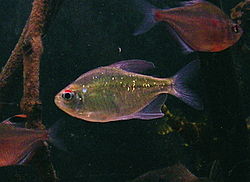- Moenkhausia pittieri
-
Diamond Tetra Scientific classification Kingdom: Animalia Phylum: Chordata Class: Actinopterygii Order: Characiformes Family: Characidae Genus: Moenkhausia Species: M. pittieri Binomial name Moenkhausia pittieri
(Eigenmann, 1920)The diamond tetra, Moenkhausia pittieri, is a small freshwater fish of the characin family (family Characidae) of order Characiformes. It is found in and around Lake Valencia in Venezuela, South America. This species exhibits clear sexual dimorphism, with males having much longer dorsal fins than the females. Males also tend to be more brightly coloured, but both sexes are attractive fish and have become popular with aquarists. The dorsal and anal fins are purple and the body is silver. The eye is marked with red above the pupil, and there is a dark band running along the midline of the body. Their common name comes from the bright, iridescent scales along the flanks. Maintenance in aquaria is simple as similar to that of other tetras, although they will not do as well in hard, alkaline water as they do in soft, slightly acidic water filtered through peat (Riehl & Baensch, 1996).
Nutrition
The diamond Tetra is an omnivore. In the wild they will eat whatever they can get, with a preference for animal food, especially Mosquito larvae. In an aquarium they will eat most normal fish foods including flakes. They benefit from a variety of food such as live daphnia or frozen bloodworms.
Aquarium Breeding
A pair of Diamond Tetras will spawn in an aquarium with an area well planted including fine leaved plants creating a well shaded area. The pair should be well conditioned before hand with rich food including live food.
The water should be very soft and a pH of 6 is preferable. A temperature of 26 degrees C (79 degrees F) is suitable.
The fish usually spawn in the early morning. They will eat their eggs and are normally removed after spawning. The eggs normally hatch in 36 hours and the fry are usually free swimming in 4 days.
The babies grow quickly. They will eat fry foods, but suitable sized live foods will help at all stages.
References
- http://aquatic-experts.com/ARTICLE_First_Ever_Photos_of_Diamond_Tetras_in_their_natural_habitat.html
- http://aquatic-experts.com/Moenkhausia_pittieri.html
- Froese, Rainer, and Daniel Pauly, eds. (2007). "Moenkhausia pittieri" in FishBase. January 2007 version.
- "Moenkhausia pittieri". Integrated Taxonomic Information System. http://www.itis.gov/servlet/SingleRpt/SingleRpt?search_topic=TSN&search_value=162986. Retrieved January 29, 2007.
- Riehl R. & Baensch H: Aquarium Atlas (vol. 1), Voyageur Press, 1996, ISBN 3-88244-050-3
- http://www.bettatrading.com.au/Diamond-Tetra-Fact-Sheet.php

This Characiformes-related article is a stub. You can help Wikipedia by expanding it.

